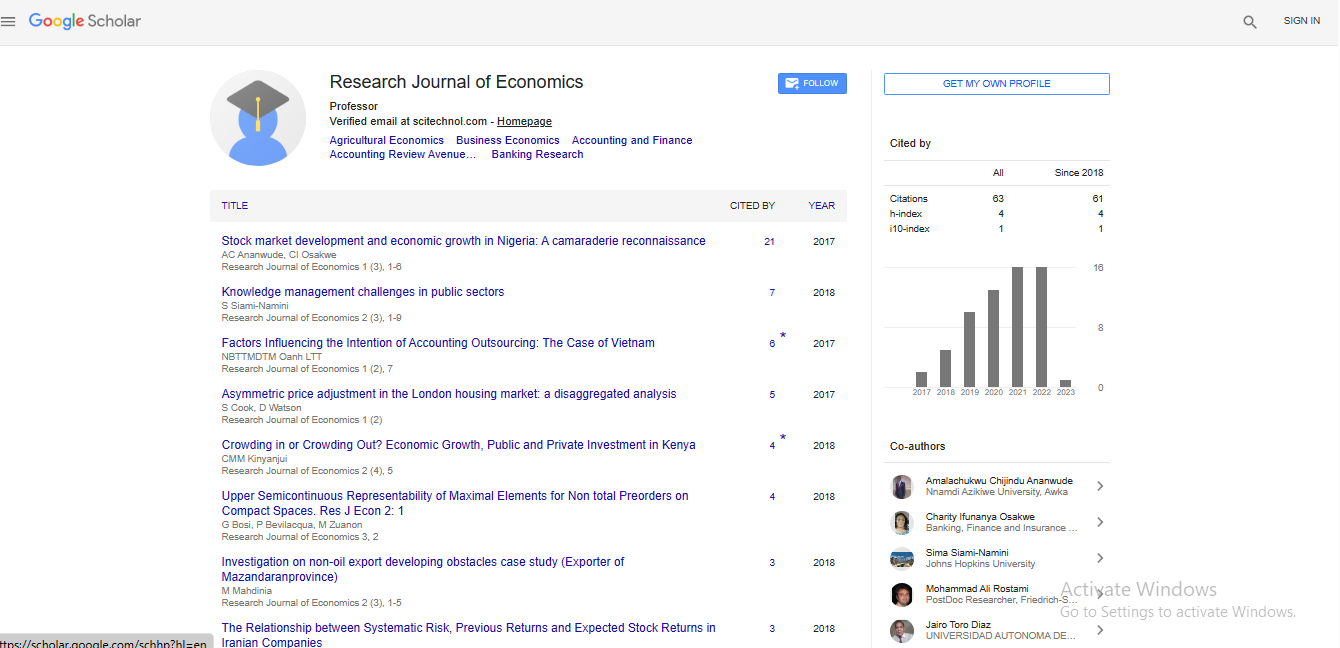Short Communication, Res J Econ Vol: 5 Issue: 6
A Portfolio is a Collection of Financial Investments
William Mathew*
Department of Economics, University of Life Sciences Poland
*Corresponding author: William Mathew Department of Economics, University of Life Sciences Poland, Tel:+483652147891, Email: william.miles97@wichita.edu
Received Date: June 05, 2021; Accepted Date: June 21, 2021; Published Date: June 29, 2021
Keywords: Macroeconomics, Panel Data Model, Small business, Social Economics, Socio Economics Status
Introduction
A portfolio is a set of financial investments like shares, bonds, commodities, cash, and cash equivalents, which include closed-stop finances and alternate traded price range (ETFs). Humans typically believe that stocks, bonds, and coins incorporate the core of a portfolio. Although that is often the case, it does no longer want to be the rule of thumb. A portfolio can also incorporate a huge range of property which includes real property, artwork, and personal investments. You can select to maintain and control your portfolio yourself, or you may permit a cash manager, financial guide, or some other finance professional to manipulate your portfolio. One of the key concepts in portfolio control is the knowledge of diversification which absolutely way no longer to put all of your eggs in a single basket. Diversification tries to reduce threat by allocating investments among numerous economic contraptions, industries, and different categories. It goals to maximize returns by using investing in one of a kind regions that would each react differently to the equal event. There are many methods to diversify. The way you select to do it's miles as much as you. Your goals for the future, your urge for food for chance, and your character are all elements in identifying how to construct your portfolio. You may think of an investment portfolio as a pie that is been divided into pieces of varying wedge-fashioned sizes, every piece representing a one of a kind asset magnificence and kind of investment. Buyers aim to assemble a nicely-assorted portfolio to gain a threat-go back portfolio allocation this is suitable for their stage of chance tolerance. Although stocks, bonds, and cash are commonly viewed as a portfolio's core constructing blocks, you may develop a portfolio with many distinctive styles of belongings together with actual estate, gold stocks, various varieties of bonds, paintings, and other artwork collectibles. The pattern portfolio allocation pictured above is for an investor with a low tolerance for hazard. In standard, a conservative method tries to shield a portfolio's fee via investing in decrease-danger securities. In the example, you may see that a full 50% is allocated to bonds, which might contain high-grade corporate and government bonds, inclusive of municipals. The 20% inventory allocation may want to contain blue-chip or massive-cap equities, and 30% of short-term investments might encompass coins, certificate of deposit (CDs), and high-yield financial savings debts. There may be as many distinctive sorts of portfolios and portfolio techniques as there are buyers and cash managers. You furthermore might may additionally pick out to have multiple portfolios, whose contents could reflect an exceptional approach or investment situation, structured for a unique need. The hybrid portfolio method diversifies throughout asset classes. Constructing a hybrid portfolio requires taking positions in shares as well as bonds, commodities, real estate, or even artwork. Commonly, a hybrid portfolio includes highly fixed proportions of stocks, bonds, and opportunity investments. This is useful, because historically, stocks, bonds, and options have exhibited much less than perfect correlations with one another. When you use a portfolio for investment functions, you anticipate that the inventory, bond, or some other financial asset will earn a return or grow in cost over time, or both. A portfolio investment can be either strategic where you purchase financial belongings with the goal of keeping onto the ones assets for a long term; or tactical where you actively buy and sell the asset hoping to obtain quick-term gains. The underlying assets in an aggressive portfolio typically might expect notable dangers searching for incredible returns. Aggressive buyers are trying to find out corporations which can be inside the early degrees in their growth and feature a unique cost proposition. Most of them aren't yet common family names. A portfolio that is defensive might have a tendency to recognition on consumer staples which can be impervious to downturns. Protecting stocks do properly in bad times as well as proper times. Irrespective of how terrible the economy is at a given time, companies that make products which can be vital to everyday existence will continue to exist. This kind of portfolio makes cash from dividend-paying shares or different styles of distributions to stakeholders. Some of the stocks inside the profits portfolio may also healthy within the protecting portfolio, but here they're decided on generally for their high yields. A profits portfolio has to generate nice coins waft. Real estate investment trusts (REITs) are examples of earnings producing investments. A speculative portfolio is great for traders which have a high level of tolerance for chance. Speculative plays may want to encompass initial public offerings (IPOs) or stocks that are rumored to be takeover goals. Technology or health care companies inside the method of developing a unmarried leap forward product additionally could fall into this class.
 Spanish
Spanish  Chinese
Chinese  Russian
Russian  German
German  French
French  Japanese
Japanese  Portuguese
Portuguese  Hindi
Hindi 